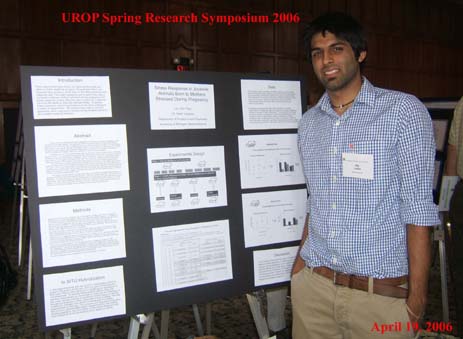During the development of an organism, early life environment, such as features of maternal care and social interactions, is very important for the proper development of the Hypothalamic Pituitary-Adrenal (HPA) Axis, a system that regulates stress responsiveness. In this project we are using an animal model of early life stress and are intended to show that how the social interactions (housing group and isolation) during the late pre-weaning and early post-weaning periods affect the animal’s glucocorticoid circadian rhythm, and how the maternal care affect the development of endocrine and behavioral responses to stress. Our study focus on Corticotropin Releasing Hormone Stress System, Serotonin Brain System and Growth Hormone Axis.
| Methodology: |   |
Student will be working with technicians to accomplish these tasks.
Minimum Qualifications: General biology courses, general chemistry courses and computer skills (Excel, Word, EndNote and Statview). Willingness to work at least 6-8 hrs per week in 3-4hr blocks.
![]() Stress
Response and Growth: Impact of Early Life Stress
Stress
Response and Growth: Impact of Early Life Stress
The focus of this project is to understand the role of critical
developmental periods which, when altered, lead to growth failure using the
rat as an animal model. Efforts are concentrated on two stages of the rat's
development, i.e., the first two weeks of life, when activation and termination
of stress can be altered in opposite directions, depending on the timing of
stressors and on the post-weaning period when the rat is no longer dependent
upon maternal care for survival. Our laboratory collaborates with Juan
F. Lopez and Seymour
Levine as we study the hypothalamus, hippocampus, and pituitary.
These structures are thought to exert important neural and endocrine control
upon the LHPA and the growth hormone (GH) axes. It is proposed to: 1) examine
the consequences of early stress (maternal deprivation at specified times in
life) or pharmacological agents (glucocorticoids) on growth parameters; 2) examine
if the individual differences in stress responsiveness resulting from maternal
deprivation or glucocorticoid treatment alter the expression of molecules linked
to a functional GH axis during development; and 3) attempt to revert the long-term
negative effects of maternal deprivation by blocking the LHPA response to stress
during early life with a CRH antagonist. This project also explores psychopathology
in families of children evaluated for short stature in a Pediatric Endocrine
clinic. Most recently we have expanded this project with Audrey
Seasholtz as we look into molecular mechanisms responsible
for growth and HPA alterations. We also have initiated a new line of work that
focuses in the Brain Serotonin System with Paresh
Patel and Charles
Neal. This
project is supported by NICHHD
branch of NIH.